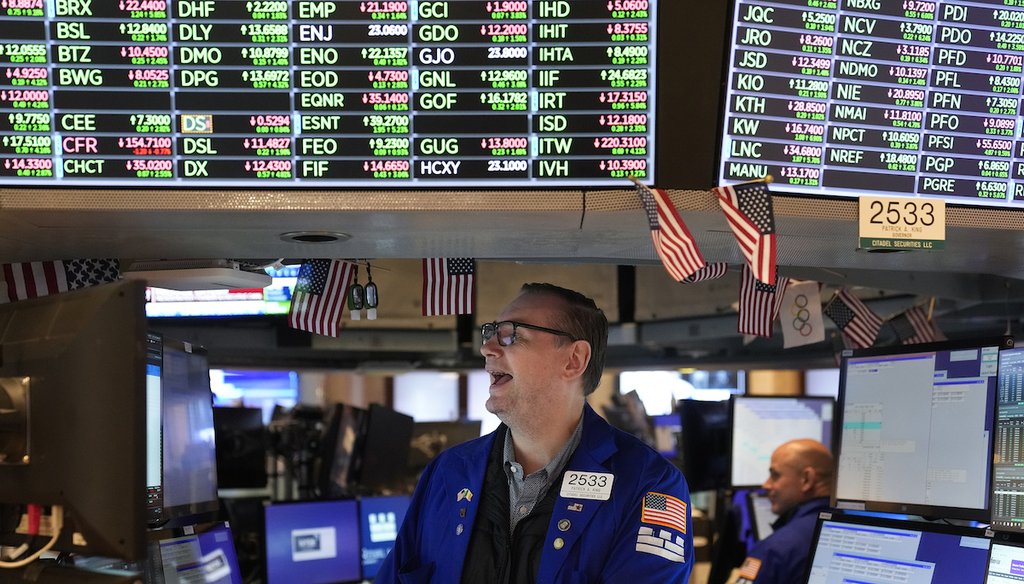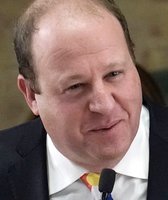Stand up for the facts!
Our only agenda is to publish the truth so you can be an informed participant in democracy.
We need your help.
I would like to contribute

Traders work on the floor at the New York Stock Exchange on Nov. 10, 2022. (AP)
If Your Time is short
• Some lawmakers have suggested that high corporate profits have been driving inflation, which is at a 40-year high. But economists say the opposite is true, with inflation boosting company profits, which are at historical highs.
• Prices rose during the COVID-19 pandemic because of supply chain disruptions and later because of Russia’s war in Ukraine, but wages didn’t rise as quickly. For companies, higher prices combined with steady labor costs has yielded higher profits.
• Because Americans were relatively flush from receiving government pandemic stimulus payments, they could pay the higher prices, removing an incentive for companies to lower them.
• Corporate profits probably won’t remain this high indefinitely, as wages rise over time and the possibility of a recession cut into consumer purchasing power.
The disconnect between 40-year high inflation and historically high corporate profits has led some Democratic lawmakers to propose cracking down on companies.
Democratic Sens. Elizabeth Warren of Massachusetts and Jeff Merkley of Oregon are sponsoring a bill that would authorize the Federal Trade Commission and state attorneys general to ban "unconscionably excessive price increases." The senators argue that "opportunistic corporations are using inflation to conceal their abuse of pricing power, exponentially increasing prices for American consumers."
A separate bill, sponsored by Sen. Bernie Sanders, I-Vt., would impose a 95% tax on "excess profits" for certain companies with average annual gross receipts of at least $500 million.
However, a range of economists mostly agreed that corporate profits aren’t necessarily driving inflation. Rather, they are almost certainly benefiting from it.
There’s little doubt that today’s corporate profits are high. Very high.
One measure economists use is profit per unit of real gross value added, which is basically a way to compare profits to business productivity. From 2011 to 2020, this metric remained fairly steady. But after the coronavirus pandemic’s onset, the metric began rising sharply. During 2022’s second and third quarters, the metric set a record, increasing nearly 50% over the typical level from 2011 to 2020.
Another metric, corporate profits as a percentage of gross domestic product, tells a similar story. In 2021, this measurement was higher than any year going back to the Great Depression.
Although profitability varies by sector, most industries are reaping significantly more profit than they were just a few years ago.
Since the recession year of 2009, corporate profits, measured in raw dollars, have doubled for the economy as a whole. But certain sectors have outpaced that: Profits are now 3.6 times higher than 2009 for retail; 4.8 times higher for transportation and for food and lodging; 5.3 times higher for manufacturing; and 7 times higher for construction.
The sharpest increases have typically occurred since the pandemic started, and there’s evidence suggesting that the pandemic changed how companies think about expenditures and profits, with workers taking a smaller share of the pie and stockholders taking a larger share.
A study by the liberal Economic Policy Institute found that between 1979 and 2019, labor costs accounted for about 62% of cost increases, capital expenditures accounted for about 27% of cost increases, and profits accounted for about 11%.
But during the pandemic’s first seven quarters, the study found, labor and capital costs accounted for 8% and 38% respectively, while profits accounted for 54%.
In the traditional way of thinking, "businesses could use the extra revenue to expand production," through increased investment in capital and production, said Aaron Sojourner, a senior researcher at the W. E. Upjohn Institute for Employment Research.
Instead, he said, corporations have focused on sharing profits with shareholders and buying back stock, practices that have hit record highs in recent years.
A company that hasn’t seen its costs rise could theoretically join the price-raising bandwagon out of sheer opportunism. But it’s more common, economists say, for inflation to directly produce higher profits.
"The rising market power, and corporations' desire to maximize profits, are not the root cause of inflation, which comes instead from the excess of aggregate demand over aggregate supply," said Kimberly Clausing, a professor of tax law and policy at UCLA School of Law.
On the supply side, the pandemic wreaked havoc on production and distribution. Some materials became harder to obtain, and thus more expensive; transportation system bottlenecks kept products from their destinations, which also raised prices.
Meanwhile, on the demand side, the U.S. government under Presidents Donald Trump and Joe Biden spent heavily to keep the economy, and especially consumer purchasing, from cratering during the COVID-19 pandemic. Once the pandemic’s throttle on travel and hospitality spending eased, consumers’ spending surged.
So, although prices were already high, government stimulus payments enabled Americans to buy the more expensive goods and services, removing the incentive for companies to lower their prices when supply conditions changed.
The portion of the price increases that wasn’t t strictly dictated by companies’ higher costs "resulted in higher profits for producers, proprietors and corporations," said Gary Burtless, an economist with the Brookings Institution, a Washington. D.C.-based think tank.
Also, wages have not kept pace with rising prices for consumer goods and services, partly because salaries for the workforce’s middle tier tend not to be adjusted for sudden changes. That means for companies, revenue has risen but labor costs have increased by less, or not at all — and companies have captured that differential as profit, said Michael Faulkender, a University of Maryland finance professor who was the Treasury Department’s assistant secretary for economic policy from 2019 to 2021.
Eventually, the market might force corporate profit rates back down, "but that would not happen overnight," Baker said.
Many Americans chafed when, after shelling out for months of record-high gasoline prices, ExxonMobil announced a record quarterly profit of $19.7 billion.
Some questioned why oil companies didn’t produce more oil to meet the rise in demand after COVID-19 health restrictions were lifted.
Expanding production would require large up-front expenditures for facilities and infrastructure. But because of concerns about climate change, the momentum has moved away from fossil fuels and toward greener energy. This means that if oil companies made big investments, they’d be on the hook to pay for them without much certainty they would eventually recoup what they’d spent.
"Unless you have an environment where the politics and the economics encourage reinvestment with a long-term payoff, you’re not going to see reinvestment," Faulkender said. "So, they return that money to investors."
If a recession occurs — a possibility as the Federal Reserve raises interest rates to tackle inflation — it would likely send corporate profits sharply downward, Burtless said. And even without a recession, there likely will be upward pressure on wages over time, which would force companies to redirect more revenue toward labor costs, at the expense of profits, Clausing said.
Some long-term trends — including the accelerating retirement of baby boomers and a decline in legal immigration since Trump’s presidency — point to continuing labor shortages. Long-term labor shortages likely would push wages higher, potentially reducing profitability to more traditional levels.
Personal savings spiked during the pandemic, when the government was distributing stimulus aid but restaurant dining, travel and other leisure activities were restricted. But personal savings in recent months have fallen below recent historical norms. That means Americans may no longer be able to afford high prices for goods and services. This could force companies to lower prices and slim their profit margins.
Our Sources
Federal Reserve Bank of St. Louis, profit per unit of real gross value added of nonfinancial corporate business, accessed Dec. 7, 2022
Federal Reserve Bank of St. Louis, shares of gross domestic income: corporate profits, accessed Dec. 1, 2022
Bureau of Economic Analysis, Table 6.19D, accessed Dec. 1, 2022
Standard & Poors "S&P 500 Buybacks Set Quarterly and Annual Record," March 15, 2022
Federal Reserve Bank of St. Louis, personal savings rate, accessed Dec. 7, 2022
Jeff Merkley, "Merkley joins Warren, Baldwin, Schakowsky and colleagues in fight to eliminate corporate price gouging," May 12, 2022
Congress.gov, "S.3933 - Ending Corporate Greed Act," accessed Dec. 8, 2022
Economic Policy Institute, "Corporate profits have contributed disproportionately to inflation. How should policymakers respond?" April 21, 2022
E&E News, "$30B of profits renews Big Oil’s clash with White House," Oct. 31, 2022
ABC News, "Are record corporate profits driving inflation? Here's what experts think," June 30, 2022
Email interview with Charles Beauchamp, assistant professor of finance at Mississippi College, Dec. 7, 2022
Email interview with Gary Burtless, senior fellow with the Brookings Institution, Nov. 30, 2022
Email interview with Dean Baker, co-founder of the Center for Economic and Policy Research, Dec. 1, 2022
Email interview with Aaron Sojourner, senior researcher at the W. E. Upjohn Institute for Employment Research, Dec. 4, 2022
Email interview with Kimberly Clausing, a professor of tax law and policy at UCLA School of Law., Nov. 30, 2022
Interview with Michael Faulkender, professor of finance at the University of Maryland and the assistant secretary for economic policy at the Treasury Department from 2019 to 2021, Dec. 1, 2022


































